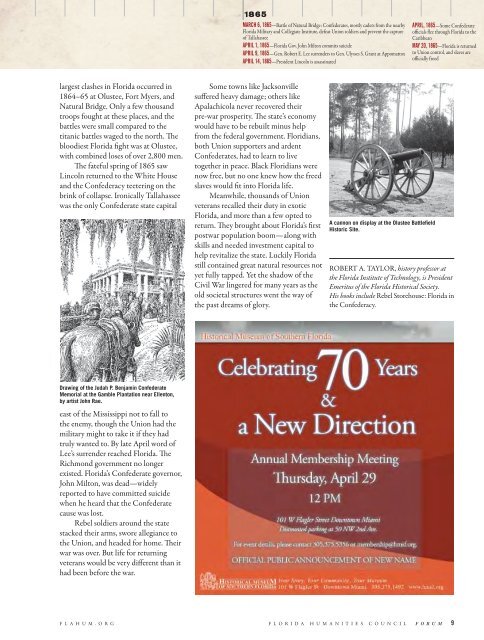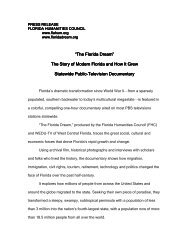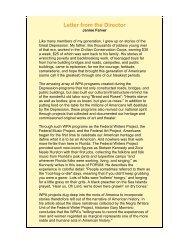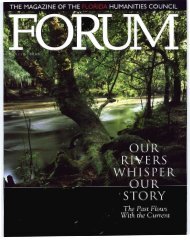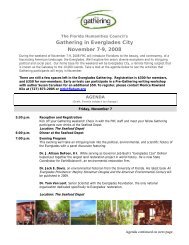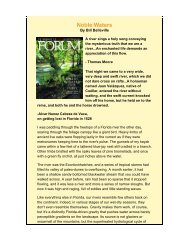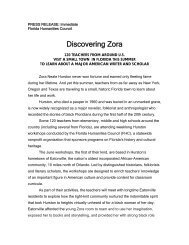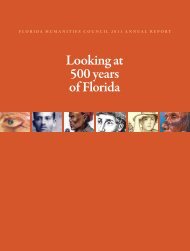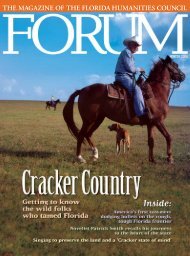when florida “Opened up the gates of hell” - Florida Humanities ...
when florida “Opened up the gates of hell” - Florida Humanities ...
when florida “Opened up the gates of hell” - Florida Humanities ...
Create successful ePaper yourself
Turn your PDF publications into a flip-book with our unique Google optimized e-Paper software.
largest clashes in <strong>Florida</strong> occurred in<br />
1864–65 at Olustee, Fort Myers, and<br />
Natural Bridge. Only a few thousand<br />
troops fought at <strong>the</strong>se places, and <strong>the</strong><br />
battles were small compared to <strong>the</strong><br />
titanic battles waged to <strong>the</strong> north. The<br />
bloodiest <strong>Florida</strong> fight was at Olustee,<br />
with combined loses <strong>of</strong> over 2,800 men.<br />
The fateful spring <strong>of</strong> 1865 saw<br />
Lincoln returned to <strong>the</strong> White House<br />
and <strong>the</strong> Confederacy teetering on <strong>the</strong><br />
brink <strong>of</strong> collapse. Ironically Tallahassee<br />
was <strong>the</strong> only Confederate state capital<br />
Drawing <strong>of</strong> <strong>the</strong> Judah P. Benjamin Confederate<br />
Memorial at <strong>the</strong> Gamble Plantation near Ellenton,<br />
by artist John Rae.<br />
east <strong>of</strong> <strong>the</strong> Mississippi not to fall to<br />
<strong>the</strong> enemy, though <strong>the</strong> Union had <strong>the</strong><br />
military might to take it if <strong>the</strong>y had<br />
truly wanted to. By late April word <strong>of</strong><br />
Lee’s surrender reached <strong>Florida</strong>. The<br />
Richmond government no longer<br />
existed. <strong>Florida</strong>’s Confederate governor,<br />
John Milton, was dead—widely<br />
reported to have committed suicide<br />
<strong>when</strong> he heard that <strong>the</strong> Confederate<br />
cause was lost.<br />
Rebel soldiers around <strong>the</strong> state<br />
stacked <strong>the</strong>ir arms, swore allegiance to<br />
<strong>the</strong> Union, and headed for home. Their<br />
war was over. But life for returning<br />
veterans would be very different than it<br />
had been before <strong>the</strong> war.<br />
F L A H U M . O R G<br />
1865<br />
MArCH 6, 1865—Battle <strong>of</strong> Natural Bridge: Confederates, mostly cadets from <strong>the</strong> nearby<br />
<strong>Florida</strong> Military and Collegiate Institute, defeat Union soldiers and prevent <strong>the</strong> capture<br />
<strong>of</strong> Tallahassee<br />
APrIl 1, 1865—<strong>Florida</strong> Gov. John Milton commits suicide<br />
APrIl 9, 1865—Gen. Robert E. Lee surrenders to Gen. Ulysses S. Grant at Appomattox<br />
APrIl 14, 1865—President Lincoln is assassinated<br />
Some towns like Jacksonville<br />
suffered heavy damage; o<strong>the</strong>rs like<br />
Apalachicola never recovered <strong>the</strong>ir<br />
pre-war prosperity. The state’s economy<br />
would have to be rebuilt minus help<br />
from <strong>the</strong> federal government. Floridians,<br />
both Union s<strong>up</strong>porters and ardent<br />
Confederates, had to learn to live<br />
toge<strong>the</strong>r in peace. Black Floridians were<br />
now free, but no one knew how <strong>the</strong> freed<br />
slaves would fit into <strong>Florida</strong> life.<br />
Meanwhile, thousands <strong>of</strong> Union<br />
veterans recalled <strong>the</strong>ir duty in exotic<br />
<strong>Florida</strong>, and more than a few opted to<br />
return. They brought about <strong>Florida</strong>’s first<br />
postwar population boom—along with<br />
skills and needed investment capital to<br />
help revitalize <strong>the</strong> state. Luckily <strong>Florida</strong><br />
still contained great natural resources not<br />
yet fully tapped. Yet <strong>the</strong> shadow <strong>of</strong> <strong>the</strong><br />
Civil War lingered for many years as <strong>the</strong><br />
old societal structures went <strong>the</strong> way <strong>of</strong><br />
<strong>the</strong> past dreams <strong>of</strong> glory.<br />
A cannon on display at <strong>the</strong> Olustee Battlefield<br />
Historic Site.<br />
APrIl, 1865—Some Confederate<br />
<strong>of</strong>ficials flee through <strong>Florida</strong> to <strong>the</strong><br />
Caribbean<br />
MAY 20, 1865—<strong>Florida</strong> is returned<br />
to Union control, and slaves are<br />
<strong>of</strong>ficially freed<br />
ROBERT A. TAYLOR, history pr<strong>of</strong>essor at<br />
<strong>the</strong> <strong>Florida</strong> Institute <strong>of</strong> Technology, is President<br />
Emeritus <strong>of</strong> <strong>the</strong> <strong>Florida</strong> Historical Society.<br />
His books include Rebel Storehouse: <strong>Florida</strong> in<br />
<strong>the</strong> Confederacy.<br />
F L O R I D A H U M A N I T I E S C O U N C I L F O R U M 9


